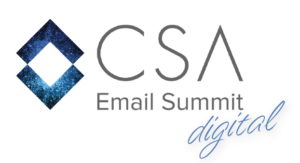Global leaders in the email industry came together in autumn 2020 for the CSA Digital Email Summit. Under the motto “Bridging the Gap – Reality vs. Expectations”, around 600 participants discussed the latest technologies and trends for sending commercial emails.
Bridging the gap between expectation and reality is often difficult – the eventful year 2020 made this particularly clear. It is also difficult to reconcile the perspectives of the senders and recipients of commercial emails. How can appropriate bridges be built in the field of email marketing? The 600 or so participants at the CSA Digital Email Summit in autumn 2020 received valuable tips on how to reconcile their differing perspectives and expectations. “Even under the difficult current conditions, we offered our participants from all over the world an extremely diverse programme,” says Maike Marx, CSA Marketing & Customer Relations. “In 2020, we again offered the best minds in the email industry the chance to expand their knowledge.” In ten English-language online panels from August to December, experts spoke about different topics from the world of commercial email.
The series of events opened with the three webinars in the Legal Insights series. Here the focus was on legal issues regarding documentation, the burden of proof and fines in email marketing. Here, the practical requirements of the General Data Protection Regulation (GDPR) for electronic communication were presented by experts. In addition to classical questions concerning the permission to send newsletters, the formal requirements and legal frameworks in other selected countries were also discussed.
Marcel Becker from Verizon Media and Clea Moore and Heather Goff from Oracle were guided by the motto of the Summit: How to Build a Bridge – A Sender’s and Receiver’s Perspective was the title of their webinar. Their key observation: ISPs and broadcasters are talking to each other more and more and trying to understand each other’s business. This leads to exciting developments. Nevertheless, it remains difficult for senders to persuade brands to adapt and invest in new technical standards such as BIMI and SCHEMA when the benefits of these technologies are difficult to measure. Marcel spoke about his mission from the perspective of the recipient: To ensure that users receive all the emails they actually want and don’t receive the emails they don’t want. Developments such as AMP, SCHEMA and BIMI improve user experience and engagement. Finally, brands can use it to deliver more relevant and engaging content.
The relationship between a brand and an ESP (Email Service Provider) is crucial for success. However, there is already a certain amount of friction when assessing who is responsible for delivery and placement in the inbox. Tamara Bond, Delivery Operations Manager at dotdigital and Alice Cornell, Director of Email Deliverability at Change.org shared what can go well and what can go badly in the webinar ESPs vs Brands: who delivers? What are the consequences when expectations do not match reality? Both also highlighted the successes that can be achieved through a symbiosis of two teams. Ultimately, brands and ESPs are on the same side.
For the webinar The Future of Email is Dynamic, the CSA invited Jon Harmer from Google and Ryth Martin from Skipify to speak. Until recently, the content of emails was purely static. Users had to leave the inbox to take action. Yahoo Mail, mail.ru, AOL and other providers are currently introducing technologies such as AMP to enable interactive emails. This is something that customers like. The conversion rates of brands can be practically doubled with dynamic emails. The two experts from Gmail and Skipify explained in their webinar how brands can easily introduce dynamic emails in which, e.g. the full shopping workflow can be completed.
What factors determine whether an email can fulfil its purpose in the recipient’s inbox? This was discussed in the webinar entitled Customer Expectations – Surprising Facts about the Reality in People’s Inboxes. Dr Conny Junghans and Arne Allisat from 1&1 Mail & Media Applications SE took an analytical look at customer behaviour. What can we all do to help people fall in love with emails again?
What we humbly call email marketing is in itself a technological and organisational blueprint for highly automated and individualised marketing. Nikolaus von Graeve, Managing Director of rabbit eMarketing GmbH, put forward this thesis in the webinar EmailMarketing? It’s relationship management! He showed: The ability to communicate individually is key to building and maintaining relationships.
The BIMI (Brand Indicators for Message Identification) standard clearly indicates who an email comes from by means of a logo in the inbox. This increases security and people’s trust in the mail. In the webinar How to use BIMI as a Brand – from the idea to GoLive, Romina Gansbühler and Peter Scholzuk, both from Josef Witt GmbH, showed how they put BIMI into practice. From the implementation of DMARC to the introduction of BIMI in 18 countries, there were several challenges to overcome.
In the Implementing BIMI workshop, Florian Vierke from Mapp Digital and Peter Scholzuk from Josef Witt GmbH, a member of the Witt Group, shared best practices first-hand. They reported on their practical experiences in working together on implementing BIMI. The change of perspectives was exciting for the audience – on the one hand, from the point of view of a brand and, on the other hand, from that of an email provider. The workshop showed exactly what to do when and how to avoid showstoppers. The Domain Name System (DNS), image settings, BIMI check and graphics formatting were examined in detail.




